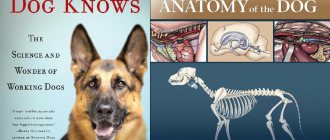Heart failure in dogs is a disease with a complex of characteristic symptoms that are associated with inadequate perfusion of organs and tissues at rest or during exercise and often with fluid retention in the body.
Simply put, heart failure is a malfunction of the heart, as a result of which it cannot pump the necessary amount of blood for the normal functioning of the body.
Not any heart disease leads to heart failure, but only one that results in a decrease in cardiac blood output and an enlargement of the heart chamber (right or left atrium).
Important! Heart failure cannot be cured. Sick animals need to be periodically observed by a veterinarian throughout their lives in order to promptly stop acute processes.
Anatomy of the heart
To better understand the mechanism of the disease, you need to have minimal knowledge about the structure of the heart.
In short, a dog's heart consists of four chambers:
- right atrium;
- right ventricle;
- left atrium;
- left ventricle
The aorta emerges from the left ventricle, and the pulmonary artery emerges from the right ventricle. The pulmonary veins flow into the left atrium (there are three in dogs, and four in humans), and the superior and inferior vena cava flow into the right atrium.
The valve apparatus of the heart plays a critical role. The role of the valves is to allow blood to flow in only one direction.
On both the left and right, the atrium and ventricle are separated by a bicuspid valve or mitral valve (in humans, there is a tricuspid valve between the right atrium and ventricle).
At the entrance to the aorta and pulmonary artery there are semilunar valves that separate them from the ventricles.
Like people, dogs have 2 circles of blood circulation - large and small.
The great circle begins in the right ventricle. From it, oxygenated blood is pushed into the aorta. Through the vessels branching from the aorta, oxygen-rich blood goes to the head, limbs and abdominal organs, where gas exchange occurs.
As a result of gas exchange, blood, already poor in oxygen, but rich in carbon dioxide, enters the right atrium through the vena cava. From the atrium, blood enters the right ventricle and the pulmonary circulation begins.
Blood enriched with carbon dioxide from the right ventricle is pushed into the pulmonary artery and “goes” to the lungs, where gas exchange occurs and the blood is saturated with oxygen. Already oxygen-rich blood flows through the pulmonary veins into the left atrium, from there into the left ventricle and a large circle begins again.
Now it will be easier to understand the causes of heart failure.
Location of the heart and circulatory system
The heart is located in the chest between the right and left lungs. The organ is located in a very thin sac made of dense, durable and very elastic tissue. This sac is called the pericardial sac. The heart is located between the 3rd and 6th ribs, with a slight shift to the left.
Blood vessels (arteries, veins, capillaries) form a network of channels that penetrate tissue throughout the body.
Causes of heart failure
Heart failure occurs as a result of:
Congenital heart defects
Defects in the anatomical structure of the heart. Such as: defects of the interventricular or intercardiac septum; aortic or pulmonary stenosis (narrowing); tetralogy of Fallot (the aorta emerges from both ventricles at once) and many other pathologies.
Congenital cardiomyopathies
As a rule, these are dysfunctions of cardiac contractility.
Characteristic for dogs:
- Arrhythmogenic right ventricular cardiomyopathy. In simple terms, the myocardium (the heart muscle itself) of the right ventricle is destroyed and replaced by fibrous and fatty tissue. Because of this, the ventricle cannot fully contract and, therefore, “push” blood out of itself.
- Dilated cardiomyopathy is characterized by dilatation of the chambers of the heart. As a result, the ability of the heart to contract is impaired, and the volume of blood that the myocardium “throws out” into the aorta and cardiac artery decreases (depending on which chamber has expanded). This is called decreased cardiac output.
Acquired diseases
Acquired heart diseases:
- bacterial endocarditis - inflammation of the inner lining of the heart caused by pathogenic microbes (streptococci, staphylococci, bortenella). Dogs become infected with the latter bacterium from cats during a fight. Bartonellosis is called cat scratch disease. As a rule, the dog first gets sick with bacterial pneumonia, pyometra, and other bacterial infections, and endocarditis can develop as a complication. It must be said that this does not happen so often, but this diagnosis cannot be excluded;
- neoplasms . Usually this is hemangiosarcoma - located in the right atrium. And chemodectoma is localized at the base of the aorta;
- secondary cardiomyopathies (hyperthyroidism);
- Cardiac tamponade is the accumulation of fluid in the pericardium (heart sac). In this case, heart failure develops if the fluid accumulated in the heart sac puts pressure on the heart itself, thereby complicating contractile processes;
- myocarditis is an inflammatory disease of the heart, as a result of which the walls of the myocardium thicken (due to cellular infiltration), contractility and conduction functions are impaired, etc. Myocarditis can develop as a result of almost any disease, both allergic, toxic and infectious, and even after mechanical damage;
- poisoning , for example, with thallium or phosphoric acid ester, etc.
Parasitic diseases
We are talking about dirofilariasis (heartworms). These helminths are carried by mosquitoes.
Heart valve disorder
This pathology may be congenital, but it manifests itself only with age.
- endocardiosis of bicuspid valves (located between the atrium and ventricle). With this pathology, the walls of the valve thicken and become deformed, as a result they no longer close tightly. The blood that goes from the atrium to the ventricle partially returns back to the atrium;
- insufficiency of the aortic and pulmonary valves. In this case, the blood cannot be completely released into the vessel from the ventricle.
Mitral valve or atrioventricular valve insufficiency
This is the most common heart disease in dogs. Females suffer from this disease less often than males. Breeds weighing more than 20 kilograms are practically not susceptible to the disease. The defect is common among the following breeds:
- Cavalier King;
- chihuahua;
- poodle;
- fox terrier;
- Charles Spaniel;
- schnauzer
As the name of the disease implies, one or more valves are affected. In 75% of cases the disease is chronic. Heart valves act as tight cusps between the chambers of the heart. Damaged valves partially lose this ability and allow blood to pass through, which can flow in the opposite direction. This backflow creates murmurs, which the veterinarian can recognize by listening to the heart through a stethoscope.
Mechanism of heart failure
Heart failure develops when the heart cannot pump blood in the required volume due to the pathologies described above.
The blood cannot fully exit into the vessel (aorta or pulmonary artery, depending on which side is affected) and remains in the heart chamber, therefore the chambers expand and the pressure increases. And then the vicious circle begins.
In simple terms, the receptors of the outgoing vessels “detect” that the blood has entered in less quantity than it should, and send a signal to the brain. But there is no signal that the heart is “overfilled.”
The body thinks that since there is less blood in the vessel than needed, then blood loss has occurred - bleeding. And it triggers compensatory mechanisms to make up for the loss:
- increases heart rate;
- retains fluid in the body;
- the lumens of blood vessels narrow.
But these mechanisms, on the contrary, make the work of the heart even more difficult and cardiac output becomes even less. Plus, tachycardia develops and the heart rhythm is disturbed.
In this case, gas exchange is disrupted, tissues do not receive enough oxygen and the entire body suffers.
Congestion also develops. Depending on the type of pathology, either in the right or left half of the heart.
Left-sided congestive heart failure, as a result of increased pulmonary venous pressure, ultimately leads to pulmonary edema.
Right-sided congestive heart failure cannot lead to pulmonary edema. With it, the jugular vein dilates, the pressure in the vena cava increases, as a result of subsequent processes, hepatomegaly develops (stagnation of blood in the liver) and fluid from the vessels leaks into the abdominal cavity - ascites.
Diagnosis
Radiography
The stage of the disease, chest shape, and hydration status influence the radiographic appearance. Generalized cardiomegaly is usually evident, although left-sided enlargement may be predominant (Figure 1). In Doberman Pinschers, the heart may appear slightly enlarged, with the exception of the left atrium. In dogs of other breeds, cardiomegaly can be pronounced and can be confused with a spherical silhouette of the heart when there is a large amount of fluid in the pericardial cavity. Dilated pulmonary veins and increased pulmonary interstitial and alveolar patterns, especially in the hilar zone and dorsocaudal region, accompany left-sided heart failure with pulmonary edema. The location of infiltrates in pulmonary edema can be asymmetric or widespread. Pleural effusion, distension of the caudal vena cava, hepatomegaly, and ascites usually accompany congestive right-sided heart failure.
Electrocardiography
Electrocardiographic findings in dogs with dilated cardiomyopathy are also variable. Sinus rhythm is common, although atrial fibrillation is common, especially in Great Danes and other giant breed dogs. Other supraventricular tachyarrhythmias, paroxysmal and persistent ventricular tachycardia, altered complexes and multiform ventricular premature beats are common findings. QRS complexes may be high (consistent with left ventricular dilation), normal in size, or low in amplitude. Myocardial disease often causes widened QRS complexes with a descending and blurred ST segment. His bundle block or other ventricular conduction abnormalities may occur. The P wave in dogs with sinus rhythm is often widened and jagged, suggestive of left atrial enlargement.
Holter monitoring throughout the day is useful for documenting frequent ventricular premature beats. It is used as a screening tool for cardiomyopathies in Doberman Pinschers and Boxers. The presence of more than 50 ventricular extrasystoles per day or any couplets or triplets indicates the future occurrence of overt DCM in Doberman Pinschers. However, some dogs with less than 50 ventricular extrasystoles per day at the time of initial examination may develop DCM several years later. The frequency and severity of ventricular tachyarrhythmias negatively correlate with shortening fraction, and persistent ventricular tachycardia is associated with an increased risk of sudden death. The variability in the number of ventricular extrasystoles in the same dog between initial and repeat Holter monitoring can be high. When available, signal-averaged electrocardiography techniques can detect the presence of late ventricular potentials, which may be suggestive of an increased risk of sudden death in Doberman Pinschers with occult DCM.
Echocardiography
Echocardiography is used to assess cardiac chamber size and myocardial function and differentiate pericardial fluid collection or chronic valvular regurgitation from DCM. Enlarged cardiac chambers and poor movement of the ventricular walls and interventricular septum during systole are characteristic findings in dogs with DCM. In severe cases, only minimal movement of the ventricular wall is detected. Usually all parts of the heart are affected, but the size of the right atrium and right ventricle may be normal, especially in Doberman Pinschers and Boxers. The systolic and diastolic dimensions of the left ventricle are increased compared to the breed norm and the ventricle appears more spherical. Shortening fraction and ejection fraction decrease (Figure 2).
Other common findings are an enlarged septal E-point and limited aortic root movement. The thickness of the free wall of the left ventricle and the interventricular septum ranged from normal to reduced. The calculated end-systolic volume index is usually above 80 ml/sq. meter in dogs with obvious DCM (less than 30 is normal). In dogs with advanced disease, systolic and diastolic dysfunction is usually evident. Doppler imaging usually reveals mild to moderate atrioventricular regurgitation (Figure 3).
Echocardiography is also used to screen for latent forms of this disease. In the early stage of the disease there may be no obvious abnormalities. Conversely, apparently healthy Doberman Pinschers may have a slightly reduced shortening fraction compared to the norm for other dog breeds.
The following echocardiographic criteria indicate a high risk of overt DCM within 2 to 3 years in asymptomatic Doberman Pinschers: left ventricular diameter in diastole greater than 46 mm (in dogs weighing less than or equal to 42 kg) or greater than 50 mm (in dogs weighing more than 42 kg), diameter left ventricular systole greater than 38 mm, or ventricular extrasystoles during the initial examination, contractility fraction less than 25%, and/or point E of septal separation greater than 8 mm.
Clinicopathological findings
Prerenal azotemia caused by poor renal perfusion or slightly elevated liver enzymes caused by hepatic congestion may occur. Severe congestive heart failure may be associated with hypoproteinemia, hyponatremia, and hyperkalemia. Hypothyroidism with associated hypercholesterolemia occurs in some dogs with DCM. Others have decreased serum thyroid hormone concentrations without hypothyroidism (euthyroid pathological syndrome); free T4 and thyroid-stimulating hormone concentrations are usually normal. Increased amounts of circulating neurohormones (eg, aldosterone, norepinephrine, endothelin, natriuretic peptide) occur primarily in dogs with DCM with congestive heart failure. Increased amounts of natriuretic peptide in dogs with occult DCM have also been reported in several studies.
A significant positive correlation has been established between the dimensions of the left ventricle (both systolic and diastolic) and the content of atrial natriuretic peptide and endothelin in the blood. Neurohormonal changes in latent DCM were not associated with time to onset of congestive heart failure or sudden death in one study; however, in dogs with overt congestive heart failure, increases in natriuretic peptide and endothelin concentrations over a period of more than a month were inversely associated with survival time. Serum troponin concentrations were elevated in some dogs with DCM as well as in other causes of myocyte injury.
Degrees of heart failure
Heart failure can be acute or chronic. As a rule, the acute stage develops as a result of shock, injury, poisoning or poisoning. If death does not occur, then the acute stage becomes chronic.
Heart failure is assessed by degrees and indices.
Degrees
- 1st degree. With it, signs of the disease are observed only after significant physical exertion.
- 2nd degree. Symptoms appear after moderate physical activity, as well as if the dog is highly overexcited (emotional stress).
- 3rd degree. Signs are noticeable after minor physical activity, possibly even at night.
- 4th degree. Symptoms appear constantly, regardless of the load.
Indexes
- A. Changes in the heart do not have a significant effect on blood circulation.
- B. Changes in the heart lead to a mild change in blood circulation.
- C. Changes in the heart significantly disrupt the movement of blood through the vessels. There are congestion in the lungs, the chambers of the heart are dilated.
- D. Abnormalities in the heart are pronounced and lead to very serious disturbances in blood circulation.
What is cardiomyopathy in dogs?
When functioning properly, a dog’s cardiovascular system ensures that all organs are supplied with blood and nutrients, which allows the animal to live and develop normally. However, the anatomy of the heart muscles can change with age, as well as due to complications after viral or bacterial infections.
The pathological transformation of the heart muscles is called cardiomyopathy.
There are several types of cardiomyopathies:
- Hypertrophic, in which the dog’s heart is increased in size. It is considered the “mildest” type of the disease, since proportional hypertrophy of all walls of the ventricles and atria occurs, that is, the heart enlarges evenly. But in order for such a large heart to work well, the dog needs to spend more strength and energy, which is not very much in older dogs. In addition, it puts pressure on nearby organs and receives less nutrition and oxygen, which can lead to a heart attack.
- With the dilated form, stretching and atrophy of the myocardium occurs, as a result of which the heart cannot contract normally and push blood through the vessels.
- The restrictive form is characterized by the formation of fibrous tissue in the thickness of the heart wall, which interferes with the normal contractility of the dog's heart.
- In the mixed form, a combination of all the above types of cardiomyopathy is possible.
As we have already mentioned, the causes of the development of cardiomyopathies are infectious diseases, complications after inflammatory diseases, heartworms, as well as serious errors in nutrition, in which there is a lack of vitamins E, B12, and selenium in food.
The main symptoms of cardiomyopathy include:
- attacks of suffocation;
- hoarse breathing;
- cardiac cough;
- heartache;
- heartbeat disturbance;
- swelling;
- fatigue;
- cyanosis of mucous membranes;
- weight loss;
- apathetic behavior of the animal.
The manifestation of such symptoms should force the owner to seek help from a veterinarian as soon as possible. After the research, the doctor will prescribe medications for your pet that he will take throughout his life.
Most often, digoxin, which prevents atrial fibrillation, and procainamide, to regulate gastric extrasystoles, are prescribed to maintain heart function. To eliminate fluid stagnation in the body, diuretics are used, in particular furosemide. The use of enzymes, such as L-carnitine, helps enhance the nutrition of the myocardium in order to prevent heart attacks.
In addition to drug therapy, it is important to correctly calculate the physical activity for the dog and create a diet in such a way that it contains a minimum amount of salt and fat, but a lot of protein and vitamins.
Symptoms
Symptoms depend on the disease causing heart failure. General signs:
- fast fatiguability;
- exercise intolerance;
- cough;
- dyspnea;
- sometimes fainting;
- the appearance of edema;
- pathological heart murmurs;
- increased heart rate (HR);
- heart rhythm disturbances;
- there may be pain on palpation in the heart area;
- disturbances in the functioning of the kidneys and liver appear;
- the worst thing that can happen is sudden death, without any previous symptoms.
The following symptoms are of great diagnostic importance:
- if there are signs of pulmonary edema, this indicates pathology on the left side of the heart;
- if we observe ascites, or stagnation of blood in the liver, we conclude that there is a disorder in the right half of the heart.
Bacterial endocarditis is characterized by:
- fever;
- lameness (non-specific symptom but worth paying attention to).
Externally appearing symptoms are not enough to make a diagnosis; it is necessary to conduct special studies to obtain data of greater diagnostic value.
Forecast
The prognosis for dogs with DCM is usually guarded to poor. Statistically, most dogs do not survive more than 3 months after the onset of clinical congestive heart failure, although approximately 25% to 40% of affected dogs survive more than 6 months if the initial response to therapy is good. The probability of survival at 2 years is estimated to be between 7.5% and 28%. However, the emergence of new drugs may change this sad picture. Pleural effusion and possibly ascites and pulmonary edema are identified as independent indicators of poor prognosis.
Sudden death can occur even when the form is latent, before heart failure becomes apparent. Sudden death occurs in approximately 20% to 40% of affected Doberman Pinschers. Although ventricular tachyarrhythmias are thought to be the most common cause of cardiac arrest, bradyarrhythmias may be the cause of cardiac arrest in some dogs.
Dobermans with latent DCM often experience worsening within 6 to 12 months. Doberman Pinschers with overt congestive heart failure identified on initial examination generally do not live long, with a reported median survival of less than 7 weeks.
If a dog with congestive heart failure is diagnosed with atrial fibrillation, the prognosis is worse. Dogs with the most severe symptoms die between 5 and 10 years of age.
In each case, however, it is reasonable to evaluate the animal's response to initial treatment before making a definitively poor prognosis. Early diagnosis can prolong life; Further cardiac evaluation is indicated for dogs with reduced exercise tolerance, weakness or syncope, or those dogs that have an arrhythmia, heart murmur or gallop rhythm.
Risk group
At risk are dog breeds that have a genetic predisposition to heart disease:
- dachshunds;
- brachycephals;
- poodles;
- Yorkshire Terriers;
- Dobermans;
- boxers (especially Arrhythmogenic cardiomyopathy);
- Great Danes and other large dogs (decompensated cardiomyopathy);
- Shepherd dogs are predisposed to hemangiosarcoma.
Also at risk are older dogs and those who have suffered an infectious disease or injury.
Bitches with pyometra (purulent inflammation of the uterus) often develop bacterial endocarditis.
First aid
If your pet has already been diagnosed with heart failure, then your veterinarian should advise you and tell you how you can help your dog during an exacerbation.
Since there are so many predisposing pathologies, there is no single mechanism of action, each case is unique.
If your pet does not have a diagnosis, but you suspect heart problems, then you need to see a veterinarian as soon as possible. The work of the heart is a complex system, and without diagnosis and proper knowledge, you can harm your dog on your own.
Causes of slow heart rate
When counting your pet's pulse, its value may be less than the normal value. If the dog is in a state of sleep, there is no need to be afraid of a slow heartbeat - this is a natural reaction of the body. But in all other situations, slow heart function (bradycardia) may indicate an unsatisfactory state of health of the animal. The dog is probably exhausted or hypothermic (by slowing down the heart rate, the body saves energy).
Bradycardia in some cases accompanies severe heart pathologies, such as cardiosclerosis and myocarditis. It may also signal the development of hypothyroidism, severe poisoning and intoxication.
The pathology is characterized by weakness, periodic fainting, nausea, and symptoms of oxygen deprivation. It is based on the weakening or cessation of the function of automatism of the sinus node (the part of the heart that generates electrical impulses). For mild bradycardia, symptomatic treatment with stimulant drugs (belladonna, caffeine, ginseng root) is prescribed. The severe form is treated with surgery (installation of a pacemaker on the heart muscle).
If you are not sure for a long time that your pet’s pulse is normal, it should be taken to a veterinary facility without delay. The causes of this disorder can be quite serious, and the doctor can prescribe effective treatment only after a comprehensive examination.
Diagnostics
A complete diagnosis is only possible in a clinical setting.
First, the veterinarian will ask you several questions, so be prepared to answer: what diseases did the pet suffer from, when did the first complaints begin, is there a cough at night, how quickly does the dog get tired?
Then the doctor conducts an examination, auscultation (using a stethoscope, listening to heart sounds, etc.).
Further special studies are required at the discretion of the veterinarian: x-ray, echocardiography, electrocardiogram.
And laboratory diagnostics: general and biochemical blood tests.
In some cases, it is necessary to do an ultrasound of the heart.
But since not all veterinary clinics are equipped with the necessary tools, diagnosis can be difficult.
Treatment
The drugs themselves are prescribed exclusively by a veterinarian after diagnosis. Most likely, you will have to continue treatment at home, but with specific prescriptions from the doctor.
As a rule, at the first and second stages the following drugs are prescribed:
- angiotensin converting enzyme inhibitors (ACEIs) - to relieve vasospasm and prevent fluid retention in the body (to prevent edema);
- diuretics.
And already at the third and fourth stages there are much more medications:
- ACEI;
- diuretics;
- calcium channel sensitizers (for example, vetmedin) the mechanism of action is that these drugs increase the force of heart contractions without increasing the heart rate;
- cardiac glycosides;
- PDE inhibitors;
- metabolic drugs (mineral supplements).
It is very important that the medications are prescribed and the dosage calculated by a specialist.
Most of these drugs have strict contraindications and serious side effects in case of overdose.
Lymphatic system
The lymphatic system is closely connected with the circulatory system and is an intermediary between it and tissues in the exchange of nutrients.
It consists of blood plasma and lymphocytes.
It is noteworthy that mammals do not have “lymphatic hearts,” unlike reptiles and amphibians, which is the name given to areas of lymphatic vessels that can contract: lymph in mammals, which lead a much more active lifestyle, moves due to contraction of the skeletal muscles.
Mammals also have lymph nodes that cleanse the lymph from harmful microorganisms.
Dog care
It is very important not to overload a sick dog, but at the same time prevent excess weight gain.
Provide your pet with a place in the house where nothing will disturb him; such dogs need peace.
Daily walks at a relaxed pace. There is no need to force the dog to run.
And of course watch your diet. The diet should be complete and balanced.
Composition of mammalian blood
The blood of mammals consists of liquid plasma, which contains a full set of so-called formed elements:
- Red blood cells are carriers of the iron-containing substance hemoglobin, they carry oxygen;
- Platelets are bodies responsible for blood clotting and serotonin metabolism;
- Leukocytes are white bodies responsible for immunity.
Red blood cells and platelets of mammals, unlike other groups of animals, do not contain nuclei.
Platelets are actually “blood platelets”; the absence of nuclei in red blood cells is explained by the need to accommodate a larger amount of hemoglobin.
Also, red blood cells do not have mitochondria, so they synthesize ATP without the use of oxygen, making them the most effective carriers of it.
Popular questions
What food to choose for a dog with heart failure?
There are special lines of food for animals with heart pathologies. In some cases, mineral and vitamin supplements, L-carnitine, etc. are necessary.
It is also very important that the dog eats his daily allowance and does not overeat. To do this, you can feed wet food - they have lower calorie content, but are more palatable.
How long do dogs with heart failure live?
It all depends on the severity of the pathology. With timely diagnosis, therapy and periodic examinations, the dog may well live until its old age.
How do dogs die from heart failure?
Dogs often die suddenly and quickly from heart failure.
Can heart failure in a dog be cured?
No. This disease cannot be treated; it is only possible to stop the development and stop the acute stages.
Normal organ sizes
The size and weight of the heart are not constant and depend on many factors:
- The age of the pet plays a big role (in old dogs the organ often becomes flabby and enlarges).
- Floor. In males, the mass of the organ is up to 20% greater than in females.
- Animal fatness.
- Physical activity. Service dogs and hunting dogs regularly used for their intended purpose have a noticeably larger heart.
It is also known that in the embryonic state this organ (relative to body weight) is simply huge. This is easily explained by the fact that at the stage of fetal maturation, the puppy’s heart pumps blood not only throughout its own body, but also through the placental network.
Briefly about the main thing
- Heart failure is a disease in which the heart cannot pump enough blood, the chambers of the heart dilate, and cardiac output decreases.
- Heart failure cannot be cured; it is a lifelong diagnosis that must be monitored throughout your life.
- Heart failure develops as a result of other cardiac pathologies, both congenital and acquired. Not every heart disease entails failure, but only those that impair hemostasis.
- The disease is classified into four degrees and four indices, depending on the severity of symptoms.
- Dog breeds at risk with a predisposition to heart pathologies include: Dachshunds, poodles, Yorkshire terriers, brachycephalics, Dobermans, boxers, Great Danes and some other breeds.
- Diagnosis of the disease is possible only in a clinical setting, after examination by a specialist and special research methods (X-ray, echocardiography, ECG, ultrasound of the heart and laboratory tests).
What heart diseases are diagnosed in dogs?
Heart problems in dogs are divided into congenital and acquired during life. Congenital heart diseases are a consequence of:
- Improper intrauterine development, resulting in the formation of a heart defect in a dog.
- Complications from an infectious disease that the bitch suffered during pregnancy.
- Genetic predisposition of certain breeds to heart disease.
Congenital heart pathologies make themselves felt at an early age (up to one year) and do not have a very good prognosis for survival. If the defect is small, then it may practically not manifest itself at all throughout life, and only during an examination at the clinic will the doctor hear a murmur in the dog’s heart. With serious cardiac problems in puppies, the following symptoms are observed:
- lethargy, drowsiness;
- poor appetite;
- shortness of breath and cough after active games and jogging;
- breathing with the mouth slightly open;
- blue discoloration of mucous membranes;
- sudden fainting.
Is it possible to cure congenital heart disease in a dog? For minor defects, the doctor may prescribe courses of supportive drug therapy and restriction of physical activity, and your dog will live with his disease for many years. In the case of serious pathology, the prognosis is most often sad, since heart surgery on a dog can only be performed by a cardiac surgeon, of whom there are very few in veterinary medicine.











